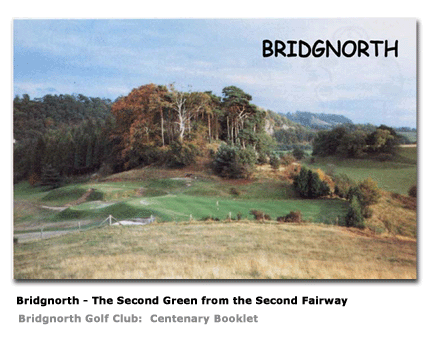|
I had a brief but happy time at Bridgnorth and it will always be a
special place for me for it was there that I met the young Lady who
was to become my wife. There was some opposition from her family,
particularly Grandma (my family knew nothing about it), so we just
went ahead on our own, with two friends as witnesses. Grandma was
sure that the union would be short lived. “I don’t know what you’re
thinking about”, she told Paddy, “Marrying a man who hits a little
white ball and walks after it for a living, in six weeks you will be
back home”. Her prediction was a little out – it lasted over
sixty-five years.

When I was working on the course Paddy would bring my tea out to me
and, on fine days, we would sit on the tree-clad hill behind the 3rd
tee (beyond the 2nd green on the left of the picture) - a delightful
corner of the course set amongst the woods and green fields of the
picturesque Severn Valley.
I left Bridgnorth in 1931 and moved to Brand Hall in Birmingham,
where I was to stay for four years – the longest period I had spent
at one club in my career so far - stability was not a feature of my
life as a professional. I was employed on a retainer of £2 per week
as pro and I had only to supervise the greenkeeping, which left me
more time for practise. Brand Hall had a decent sized practise
ground and I made full use of it, going ‘through the bag’ each day
and hitting at least 500 balls, often more. Fortunately I had a
caddie to field them so I was spared the task of picking them all
up. I was now confident that I had the game to compete and soon I
was entering all the competitions available to me, following the
pattern for club pros at that time – play a tournament one week and
catch up on club affairs the next. Golf was not a big spectator
sport then–you were lucky to get five thousand watching in a week,
and of course there were no stands.
That June the Ryder Cup was played at the Scioto Country Club,
Columbus, Ohio, where Bobby Jones had won the 1926 US Open and where
Jack Nicklaus would play his first shot twenty years later. A lot
was expected of the British team following that first victory at
Moortown in 1929, but the trip was to be overshadowed by controversy
and labelled a fiasco; the result was a 9-3 defeat. The oppressive
heat of Scioto did not suit the British (in future matches were to
be arranged for September) and they were without three key players,
including the rising star, Henry Cotton, who had made his debut at
Moortown and defeated Al Watrous to ensure a home victory. He had
been picked for Scioto but withdrew when the PGA ruled that
exhibition money would be equally shared, which he
NEXT |

